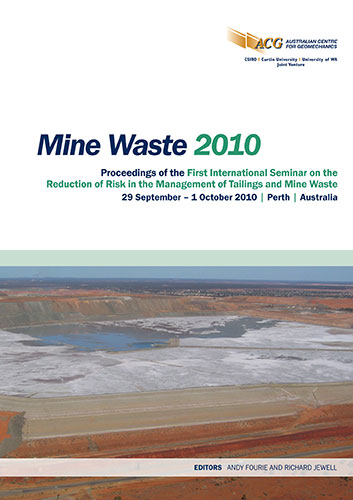Providing context to acid metalliferous drainage assessments

|
Authors: Rousseau, PDS |
DOI https://doi.org/10.36487/ACG_rep/1008_29_Rousseau
Cite As:
Rousseau, PDS 2010, 'Providing context to acid metalliferous drainage assessments', in R Jewell & AB Fourie (eds), Mine Waste 2010: Proceedings of the First International Seminar on the Reduction of Risk in the Management of Tailings and Mine Waste, Australian Centre for Geomechanics, Perth, pp. 333-344, https://doi.org/10.36487/ACG_rep/1008_29_Rousseau
Abstract:
The why, what, how, when, where and whom questions with respect to completing an acid metalliferous drainage (AMD) assessment are outlined in this discussion. Why? AMD has been recognised as the most significant potential long-term liability associated with mining, particularly post closure. The requirement to understand AMD is thus driven by corporate governance, financing and regulatory considerations. What? The current definition (GARD Guide, 2009; and other guideline documents) of what an AMD assessment should include is broad. It includes acidity that is released through sulphide oxidation, but also covers release of other elements that are mobile under acidic, neutral, or alkaline conditions, as well as introduced contaminants. The purpose of these assessments is thus to identify all mining-related sources of potential contamination. How? To achieve a realistic AMD assessment, specialist knowledge about geochemistry, hydrogeology, engineering and management details of a project is necessary to evaluate AMD risk, to model systems in question, and to develop mitigation strategies. To evaluate the potential for impacts it is necessary that contaminant sources, transport pathways and receptors be identified and that their physical and geochemical properties must be adequately quantified. These properties must also be related to the mining operation using a suitable site conceptual model. When? AMD assessment should commence at the exploration stage, once sufficient geological information and sample material is available to obtain a realistic view of ore and waste geochemistry. The earlier the evaluation starts, the sooner AMD related liabilities and technical challenges associated with geochemistry for a mining project become known. Where? The AMD assessment should consider all materials to be disturbed by mining that could potentially result in significant geochemical changes and associated mobilisation of acidity or other potentially harmful substances. Whom? An AMD assessment should be carried out by technical specialists, suitably knowledgeable about geochemical and hydrogeological processes. Sufficient geological background is required to conceptualise relevant geological factors associated with a mining operation. It is also necessary for geological, mining and engineering personnel associated with a project to provide input to these assessments, as their information and activities can have a major influence on AMD related outcomes associated with material management.
References:
AMIRA International Limited (AMIRA) (2002) ARD Test Handbook, Project P387A Prediction & Kinetic Control of
Acid Mine Drainage, AMIRA International Limited, Melbourne, Australia.
Providing context to acid metalliferous drainage assessments P.D.S. Rousseau
344 Mine Waste 2010, Perth, Australia
Department of Industry Tourism and Resources (DoITR) (2007) Managing Acid and Metalliferous Drainage, Leading
Practice Sustainable Development Program For the Mining Industry, Department of Communications,
Information Technology and the Arts, Canberra, Australia.
Global Acid Rock Drainage (GARD) Guide (2009) International Network for Acid Prevention (INAP),
www.gardguide.com.
Kirschner, L.A. and Grandy, E.B. (2003) Mining and the Vanishing Surety Bond Market, Parsons, Behle & Latimer.
Kuipers, J.R., Maest, A.S., MacHardy, K.A. and Lawson, G. (2006) Comparison of Predicted and Actual Water Quality
at Hard Rock Mines, The reliability of predictions in Environmental Impact Statements, EARTHWORKS,
Washington DC, USA.
Price, W.A. (1997) Draft Guidelines and Recommendations for the Prediction of Metal Leaching and Acid Rock
Drainage at Minesites in British Columbia, Reclamation Section, Energy and Minerals Division, Ministry of
Employment and Investment, Smithers, British Columbia.
Price, W.A. (2009) Prediction Manual for Drainage Chemistry from Sulphidic Geologic Materials, MEND Report
1.20.1. CANMET Mining and Mineral Sciences Laboratories, Smithers, British Columbia.
Sobek, A.A., Schuller, W.A., Freeman, J.R. and Smith, R.M. (1978) Field and Laboratory Methods Applicable to
Overburdens and Minesoils, Report EPA-600/2-78-054, U.S. National Technical Information Report PB-280
495.
© Copyright 2025, Australian Centre for Geomechanics (ACG), The University of Western Australia. All rights reserved.
View copyright/legal information
Please direct any queries or error reports to repository-acg@uwa.edu.au
View copyright/legal information
Please direct any queries or error reports to repository-acg@uwa.edu.au